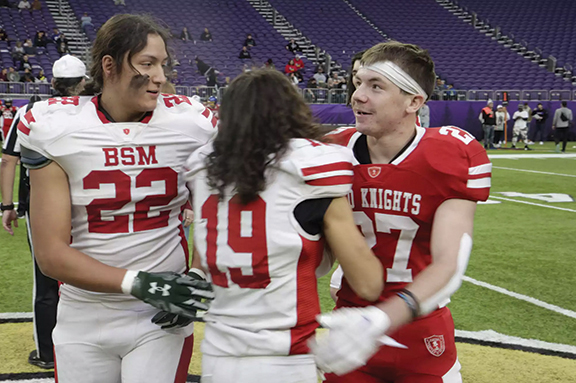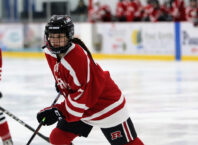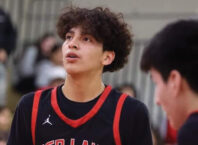
by Matt Sepic/MPR News
Student-athletes representing dozens of tribes played at U.S. Bank Stadium Dec 11 in the fifth annual Indigenous Bowl. The game is part of an effort to highlight athletic talent from schools that might otherwise escape the notice of college recruiters.
The players – all high school seniors – split into two teams designated by red and white jerseys, and took to the field after a coin toss by U.S. Sen. Tina Smith. Hundreds of friends and family cheered them on from the stands.
Just after stepping off the field at halftime, Gaabi Boucha of Warroad High School said it was a thrill to play on NFL turf.
“It’s breathtaking, honestly. I came out for warmups and it really just took my breath away just looking up and seeing stands go as high as the sky,” he said.
Boucha is Ojibwe and plays running back and middle linebacker. He was one of 75 athletes, including three from Minnesota, chosen for the Indigenous Bowl.
Bennae Calac is executive director of the 7G Foundation – the Native American advocacy group that sponsors the event. She says past Indigenous Bowl players have caught the eye of college coaches including at the University of Minnesota Morris.
“A lot of our athletes have gone on to play at different colleges: [Division] II, DIII, I think we had a DI,” she said. “We have helped continue their dreams to obtain their education as well as continue playing in football.”
She said the effort, a partnership with the NFL, started in 2017 to provide mentorship and skills development to promising Native athletes. This year nearly 500 students submitted applications.
Calac – who’s with the Pauma Band of Luiseño Indians in southern California – said winnowing the roster down to 75 participants is a painstaking process. That’s because Indian Country high schools are generally small, and many don’t have the resources to enable athletes to submit videos of themselves in action.
“And so what we have to do is call the individuals’ schools, we have to track them down, but we do it because we believe in the opportunity,” Calac said.
Lyle Uses Arrow Jr. drove from the Standing Rock Sioux Reservation in North Dakota to watch the game. He said his nephew – Adam Eagle Shield – found out about the Indigenous Bowl on social media and was thrilled to be able to play on the Vikings’ home field.
“This is something we never dreamed about. We always talked about coming to games here, but we never got around to it because we’re so busy,” he said. “But this is something, a real eye opener, and it’s awesome to be here.”
This is the second year that the Vikings have hosted the Indigenous Bowl. Calac said she hopes to grow the event to include regional competitions to ensure that more talented Native high school football players get the opportunities that they deserve.






